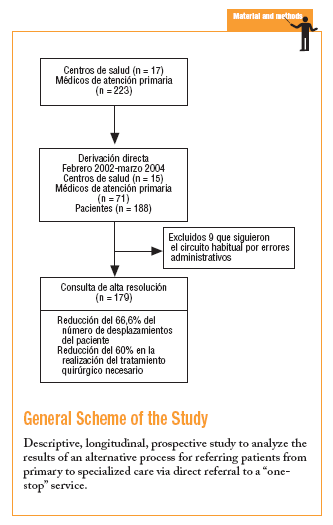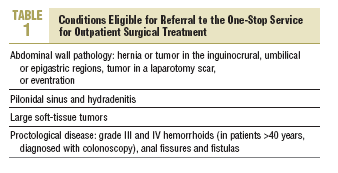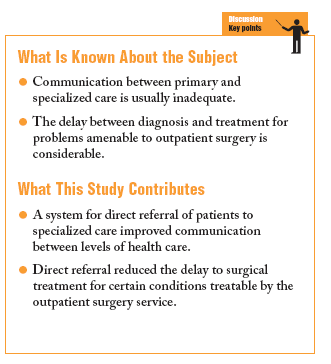Introduction
More than 90% of the target population's health problems are resolved at the primary care (PC) level,1,2 and one of the main functions of the family physician is to manage referrals of the small percentage of remaining patients to specialized care (SC). Appropriate, prompt referral solves the patient's problem within a short period of time and decreases the number of emergency service visits. However, prompt referral is not always possible because of communication problems3-5 and the bureaucratic impediments that separate PC and SC, which generate long waiting lists for appointments with a specialist.
For referrals to general surgery, which account for 10.7% of all referrals,2,4,6 we have found that a large percentage of the conditions for which patients are referred in our setting can be easily diagnosed by the PC physician, and that these conditions can now be treated without the need for hospital admission. In addition, at the major outpatient surgery (MOS) unit, where these patients are treated in our setting, patient satisfaction surveys have shown that patients wish to obtain treatment for their conditions more rapidly. These findings led to the creation of a "one-stop" outpatient surgical service which provides all health care actions these patients need on the same day.7-9 Access to this service is via direct referral by their PC physician, as a measure to improve communication between PC and SC, provide surgical treatment to patients who need surgery as soon as possible, and avoid trips to the hospital. This approach was intended to enhance the quality of care and enable the patient to resume normal daily activities promptly. The aim of this study was to analyze the results of the "one-stop" MOS service designed as part of a program to enhance collaboration between PC and SC.
Patients and Methods
This was a prospective, descriptive, longitudinal study involving patients in Health Area 7 in the city of Madrid, central Spain. This report describes the operation of the one-stop service from its inception in February 2002 until March 2004. The study was carried out at the MOS unit of the Hospital Clínico San Carlos in collaboration with health centers in Area 7.
One-Stop Service
Before launch, the staff of the MOS unit and health centers met to agree on how the one-stop service was to operate and to develop referral guidelines together, with input from the primary care administration and accounts offices. A meeting was also held with the service management board. One meeting was held with PC physicians to inform them about the referral system, and two additional meetings were held with the one-stop service staff after the system had begun to operate to inform participants about the results, answer questions and receive suggestions regarding the inclusion of other conditions.
Patient Selection
Patients were selected by PC physicians if they had any of the conditions shown in Table 1 that could be treated by outpatient surgery. Inclusion and noninclusion criteria for this type of treatment are shown in Table 2. As part of the referral agreement, PC physicians were asked to complete preoperative studies at the health center, including blood tests, x-rays and electrocardiogram so that patients could bring these results with them when they came to the hospital for their preoperative appointment.
The patient´s hospital appointment with the one-stop surgical service was scheduled by the health center. At the one-stop service the patient was examined by a staff surgeon at the MOS unit. On the same day the patient was seen by the anesthetist, surgery was scheduled, and the patient was given information about the procedure and instructions about how to prepare for outpatient surgery. With this system the patient needed to travel to the hospital only twice: once for the preoperative appointment and again on the day his or her surgery was scheduled. A report was sent to the patient's PC physician via internal mail.
Study Variables
Number of patients, age, sex, and referring center were recorded. Other variables were participation by PC physicians, number of patients with each diagnosis referred, and diagnostic concordance between the PC physician and the MOS surgeon. Compliance with inclusion and noninclusion criteria, preoperative tests, delay between referral and surgery, and number of trips made by the patient were noted. Referral rate was calculated for each condition as the patients seen at the one-stop service for a given condition divided by all patients treated at the MOS for that condition.
Results
During the 25-month study period, 188 patients were referred from 15 of the 17 participating health centers. Of these patients, 95.2% were seen at the one-stop service and 4.8% did not attend their preoperative appointment.
A total of 71 PC physicians participated (32% of all PC physicians in Area 7), and 53.5% of them referred more than 1 patient.
Mean age of the patients was 50.8±19.3 years, and 80% of them were men. The conditions for which patients were referred are listed in Table 3. Diagnostic concordance between PC and SC physicians was 96%, although 10% of the patients did not fulfill the inclusion criteria or had a condition that was not on the list of those eligible for referral. These patients were admitted for surgery with a short hospital stay or referred to other specialists. Nine percent of the patients did not bring all the results from the preoperative work-up with them.
Mean time from referral by the PC physician to surgery was 1.9±1.2 months, as compared to a mean wait of 4.8 months (60% reduction) for the usual referral process (Figure). We did not exclude from these calculations vacations, the month of August (when many people in Spain are on their yearly vacation), Christmas vacation or Easter week vacation, when the one-stop unit was closed, or patients' personal circumstances that led to delays in surgery (associated disease, family problems, etc). The number of trips to the hospital, including the day surgery was scheduled for, was 2 for all patients except the 9% who did not bring the results of their preoperative tests with them; these patients needed 4 trips to the hospital. This translated as a reduction of 66.6% and 33.3% respectively in comparison to the usual 6 trips.
The overall referral rate was 12.6%; referral rates for each diagnosis are shown in Table 4.
Discussion
The one-stop service model10 can be adapted to many problems which, because of their prevalence, justify implantation of strategies to decrease delays and facilitate access to specialized care. This is why hospitals and specialty centers across Spain are adopting this system.7-12
The system termed one-stop service in the present study differs somewhat from the accepted concept, as complementary tests needed for the preoperative work-up were not done on the same day, but were ordered by the PC physician so that the results could be brought to the hospital by the patient on the day of his or her preoperative appointment. Moreover, because we studied conditions that required surgery, actual treatment was postponed until the date of surgery. A more appropriate term would therefore be "direct referral,"13 in which the referral mechanism foments relations between PC and SC and shortens the delay to the patient´s benefit.
Improved Communication Between Primary and Specialized Levels of Care
The relation between the two levels of care is favored in two evident ways. First, the PC physician is involved in the diagnosis so that the patient is referred to the appropriate specialist; as a result the information the patient brings to the appointment with the specialist is greater than with the usual referral circuits.4,14 Secondly, by shortening the delay between diagnosis and treatment, the information generated can readily be compiled in a single report that will not circulate from office to office, but will be delivered to the PC physician promptly3 as the final link in the circuit. We should add that patients' satisfaction when they obtain prompt treatment and resolution of their problem improves their relationship with the PC physician who arranged for treatment first-hand. Moreover, the number of visits needed during the wait for treatment decreased. The consequences were enhanced trust and a more cordial atmosphere during PC visits.
In the present study, the one-stop service created opportunities for communication between PC and SC levels that started with the preliminary meetings to agree on how and when the new system would operate. Thereafter, owing in part to personal acquaintances between physicians at the different centers, relations were based not only on the two-directional flow of information about patients via internal mail, but also on periodic reports of how the one-stop service was working and on meetings to extend the program by including other conditions in a later phase. Such proposals arose at the initiative of the PC physicians (for example, the referral of 2 patients with cholelithiasis for surgical treatment). Moreover, questions that arose were resolved on the spot with a telephone call.
Enhanced Patient Care
The most notable benefit patients obtained with this model of referral was the shortened delay between diagnosis and the surgical procedure. Because fewer steps were needed to obtain treatment, the mean delay of 5 months was reduced to somewhat less than 2 months (60% reduction); moreover, trips to the hospital were reduced to 2, one on the day of the one-stop preoperative appointment and one on the day of the operation (66.6% reduction). In a large city such as Madrid, where travel time is considerable (some patients needed more than one means of transport to reach the hospital for their appointment with the specialist), reducing travel requirements had a direct effect on user satisfaction. If we add to this the social and occupational problems each appointment for medical care involves, the reasons why patients appreciated reducing trips to a minimum are readily appreciated.
Another positive finding in the present study was the high rate of diagnostic concordance between AP and SC physicians, as a result of involving both levels of care in the program from its inception.13,15 The efforts PC physicians devoted to investigating and diagnosing each patient and becoming involved in the preoperative work-up despite the pressures of a large patient load merit particular mention. The use of a concise referral protocol for specific conditions and patient characteristics, and the willingness of SC physicians to answer the family physician's questions personally, facilitated this task and contributed to the favorable results.
One aspect that will require further improvement is the degree of participation by PC physicians, as increases here would lead to increases in referral rates. Eventually our goal is for all patients eligible for outpatient surgical treatment to obtain access to the MOS unit via the direct referral system. Another challenge is the inclusion of additional diseases and conditions. In this sense the program continues to evolve as other conditions are included in response to requests by PC physicians.
In conclusion, we wish to emphasize the potential of this type of program in terms of feasibility, acceptability and cost-effectiveness on the basis of the results reported here. Such a one-stop system may manifestly improve the quality of patient care and relations between primary and specialized levels of care. Because the conditions for which it has been used thus far are among the most prevalent, large numbers of patients may benefit from this system, which is exportable to other medical and surgical specialties in other health care settings.





















